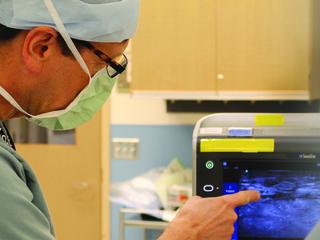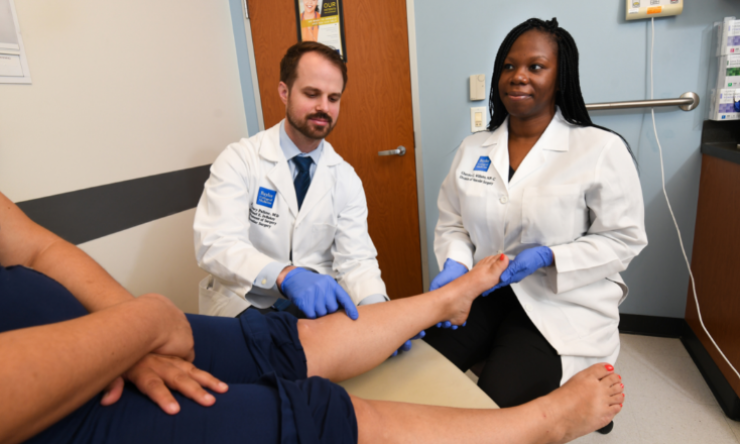What Is the Connection Between Diabetes and Limb Loss?
Diabetes is a multifaceted condition that can result in severe complications, including limb loss. Two major concerns are poor circulation and diminished sensation in the feet, which heighten the risk of foot ulcers, non-healing wounds, and infections. Without proper treatment, these issues can worsen and ultimately lead to limb amputation. Understanding the risk factors is crucial to prevention and early intervention.
Individuals at higher risk include:
- Long-standing diabetes or kidney failure: Chronic conditions that compromise circulation and healing.
- Current or former heavy smokers: Smoking damages blood vessels, significantly impairing circulation and wound healing.
- People with non-healing foot wounds: These can be early indicators of poor circulation or infection.
- Adults over age 55: Age-related vascular changes can increase the likelihood of complications.
- Those with claudication (leg pain during exercise): Progressive pain in the calves while walking or running may signal poor blood flow and vascular disease.
Recognizing these risk factors and seeking prompt medical attention can make the difference in preserving limb function and quality of life.
Jose Samano faced a dire situation with a severe foot infection and peripheral vascular disease which led multiple surgeons to suggest leg amputation. However, Dr. Tyler Coye, a foot surgeon at Baylor Medicine specializing in limb salvage, saw the potential to save Samano's leg.
Can Amputation Be Prevented?
STEP: Save the Extremity Program
Save the Extremity Program (STEP), part of the Division of Vascular Surgery and Endovascular Therapy, is a clinical and research collaboration dedicated to recognizing diabetic foot-related conditions and providing interventional treatments to prevent amputations and save limbs. Our exceptional STEP team includes vascular surgeons, podiatrists, wound care specialists and researchers, who give patients access to the latest, state-of-the-art, minimally invasive vascular interventions, open surgery, wound care and wearable technology available. Our STEP professionals work to keep patients complication free, mobile and independent. Call for more information today at (713) 798-5700.
What Is the "Toe and Flow" Model?
Our limb salvage program seamlessly integrates vascular surgery and podiatry for both the outpatient and inpatient.
Our limb salvage program is built on the toe and flow model, a seamless integration of podiatry and vascular surgery for comprehensive care of both outpatients and inpatients.
Podiatrists are often the first to identify signs of peripheral artery disease (PAD), a critical factor in limb preservation. In our program, podiatrists collaborate closely with vascular surgeons and radiologists to diagnose and treat conditions affecting the foot, ankle, and lower extremity.
- Flow refers to the vital role of blood flow in wound healing. Vascular surgeons are experts in restoring and optimizing circulation, ensuring the foundation for recovery.
- Toe encompasses all procedures and care necessary to heal the foot and toes. Podiatrists bring specialized expertise in foot surgery, wound management and limb preservation.
Together, this integrated approach ensures the best outcomes for patients facing complex foot and vascular conditions.
How Is Diabetic Foot Diagnosed and Treated?
Diagnosing and treating diabetic foot conditions requires a multidisciplinary approach, combining advanced diagnostic tools and specialized care from both vascular surgeons and podiatrists to ensure optimal outcomes.
Diagnosis
Our team employs state-of-the-art diagnostic tools to evaluate arterial health and foot integrity.
- Vascular Diagnostic Tools:
- Ultrasound-guided imaging: Provides real-time visualization of arterial flow, identifying blockages with precision.
- Advanced imaging techniques: Tools like CT angiography and MRI provide detailed evaluations of blood vessel health and tissue structures, guiding targeted interventions.
- Podiatric Diagnostic Tools:
- Monofilament testing: Detects loss of protective sensation in the feet, a critical early sign of neuropathy.
- Biomechanical assessments: Evaluates gait, pressure points, and structural abnormalities that increase the risk of ulcers.
- Wound evaluation: Employs advanced techniques, including tissue perfusion analysis to assess wound oxygenation and viability.
Vascular Procedures
Our highly trained group of surgeons have mastered the following procedures that lead to increase in the blood flow to the foot, which then allows better healing rates.
Podiatric Procedures
- Surgical Debridement
- Tendon Lengthening Procedures
- Partial Foot Amputations
- Advanced Skin Substitutes
- Negative Pressure Wound Therapy (NPWT)
- Rotational, Advancement, and Transposition Flaps
- Bone Resection Procedures
- Custom Orthotics and Offloading Devices
- Pedal Soft Tissue Coverage Techniques
- Infection Control Procedures
This comprehensive approach combines advanced surgical techniques, cutting-edge technology, and a multidisciplinary strategy to maximize patient outcomes in diabetic limb salvage.
What to Expect From Your Visit
The primary goal in ulcer management is to heal the wound as quickly as possible. Prompt intervention minimizes the risk of infection, hospitalization and potential amputation.
During your visit with a wound specialist, several essential steps may be taken to effectively manage your foot wound:
- Assessment of blood flow: Ensuring proper circulation is critical for healing and preventing complications.
- Wound debridement: Removal of dead or infected tissue to promote healthy tissue growth.
- Application of medications or dressings: Specialized treatments and dressings will be applied to protect the wound and support healing.
- Infection prevention: Antibiotics may be prescribed to reduce the risk of infection or address existing concerns.
- Offloading: Reducing pressure on the affected area is vital for healing. This may involve the use of a custom shoe, boot or other offloading devices.
Your specialist will create a personalized treatment plan designed to optimize wound healing and prevent further complications.
Will I Require Surgery?
Most non-infected foot wounds can be treated successfully without surgery. However, if conservative treatments do not achieve the desired results, surgical intervention may be necessary. Depending on your condition, surgical options may include:
- Bone removal or shaving: Addressing structural issues or reducing pressure points to facilitate healing.
- Surgical wound debridement: Cleaning the wound to remove dead tissue and reduce the risk of infection.
- Correction of foot deformities: Procedures to address issues such as hammertoes, bunions or bony prominences that contribute to ulceration or discomfort.
- Blood flow restoration procedures: Revascularization techniques to improve circulation and enhance wound healing.
Your care team will assess your individual needs and recommend the most effective treatment plan, prioritizing limb preservation and optimal recovery.
Outcome
Limb salvage is a complex process, and long-term success requires a commitment to a healthier lifestyle. While no procedure can guarantee a permanent solution, the dedicated team in the Division of Vascular Surgery and Endovascular Therapy will collaborate closely with you, your family and your primary care provider to ensure the best possible outcome.
For many patients, our advanced limb salvage techniques can mean the difference between a minimally invasive procedure and the loss of an entire leg, offering hope and improved quality of life. Together, we are committed to preserving mobility and independence while minimizing the need for extensive interventions.
Clinical Trials
Our multidisciplinary team of vascular surgeons, podiatry specialists, biomechanical engineers and researchers are at the forefront of innovation, actively developing and testing cutting-edge techniques for the treatment of peripheral artery disease (PAD). Through collaborative research and advanced clinical practices, we aim to redefine care and improve outcomes for patients.
A second chance at life: Discovering an alternative to diabetic foot amputation
The Save the Extremity Program (STEP) at Baylor College of Medicine, founded by Dr. Joseph Mills uses the latest technology to save the limbs of diabetic patients.
Tips for Diabetic Foot Care
Patients with diabetes lose feeling in their feet and are at risk for developing wounds that can become difficult to heal. This scenario is avoidable for many people through proper diabetic foot care.








 Credit
Credit


